|
ANIAKCHAK
Beyond the Moon Crater Myth A New History of the Aniakchak Landscape A Historic Resource Study for Aniakchak National Monument and Preserve |

|
CONCLUSION
Aniakchak:
The Place People Do Know, and Have Known, For A Very Long Time!
Ten years ago, when I first began with my loyal young college men and faithful dogs annual trips of scientific exploration to the North, I thought that Alaska was just a worthless knob of land on top of America where Eskimos lived in igloos amid desolation of snow and ice. I was certainly surprised to find that it was anything but this. Popular notions of Alaska are for the most part all wrong. It is the least understood of any United States territory. Its size, its extent and its great variety are by no means comprehended. It is truly the land that nobody knows.
Father Bernard Hubbard, excerpt from the short film Alaska's Silver Millions, directed by Beverly Jones, narrated by Father Bernard Hubbard. Carousel Films, 1936.
It is said that a good academic sets out to challenge established popular and scholarly ideas put forth and presumably confirmed by previous generations. To his credit, the Glacier Priest declared that he had come to the Far North to disprove a myth—a myth created by publishers, professionals, and politicians about Alaska after the United States purchased the territory from Russia in 1867. This, of course, was the icebox myth, Seward's Folly. This view assumed that Alaska was nothing more than a frozen wasteland, stuck in a primitive time. Through his journeys into the Caldera, Hubbard proved to the rest of America that Alaska was anything but a desolated waste land of ice and snow. He used the Aniakchak landscape as his laboratory to demonstrate that the Far North was dynamic, active, and alive. But as the Glacier Priest became caught up in the world of publicity stunts and sensationalistic media, he tailored the presentation of his Aniakchak experiences to conform to the expectations of non-Alaskan audiences, already accustomed to the high drama of exploration, who wanted entertainment, not scholarly discourse. As Kathy Price notes, Hubbard's instant fame compelled the Glacier Priest to "succumb to the temptation to exaggerate." [1] As one Alaskan Jesuit missionary observed, Hubbard's writings were, "subjectively true, objectively false." [2] Thus, in Hubbard's attempt to maintain the interest of his audiences by molding an image of a scientist-explorer, instead of debunking a popular myth, the Glacier Priest created one of his own.
For far too long now, the interconnected environmenral and cultural relationships associated with Aniakchak have been overshadowed by Hubbard's Moon Crater myth. For twenty-five years, a large portion of the Aniakchak region has been protected by the federal government as the Aniakchak National Monument and Preserve—a legacy of the Alaska National Interest Lands Conservation Act of 1980. On the surface, there seems little reason to doubt that much of the region—inside and outside the parklands—meet the legal criteria specified by the 1964 Wilderness Act. Most visitors erroneously experience this portion of the central Alaska Peninsula "as an area where the earth and its community of life are untrammeled by man, where man himself is a visitor who does not remain." [3] Those that see only pristine wilderness experience nature from the outside looking in and they fail to understand the complex human story that unfolds in Aniakchak, a place known by many for a very long time.
At first glance, evidence that an enduring, intimate historical relationship between man and nature took place here is not apparent, for most of the cultural items that the NPS manages in the actual park unit are scattered archeological sites, a few trapper cabins, and a deteriorated cannery bunkhouse. Most historic artifacts are often so subtle that many visitors see them as "eyesores" or fail to notice them at all. With only 154 recreational visits made to the Aniakchak National Monument and Preserve in all of 2003, it is easy to understand how visitors can feel as though they had just entered a large and lonely universe. [4]
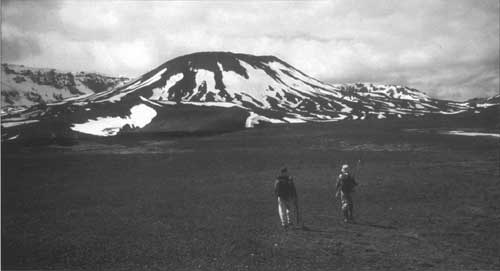
|
| Geologists enroute to Vent Mountain, 1992. Photograph courtesy of Game McGimsey, USGS, Anchorage, Alaska. |
Still, the intent of Beyond the Moon Crater Myth was to dig deeper into the past. It aimed to show that while the Aniakchak region possesses an extraordinary natural landscape, it is also a land that has maintained a 9,000-year-old human history—a history profoundly intertwined with the "untouched" natural world that visitors to Aniakchak often hope to find. To fully understand the significance of this story, rather than thinking of Aniakchak as a place forgotten by time, visitors need to begin by thinking of the region as a physical and environmentally dynamic place, affected by and connected to larger historical trends. Instead of a primitive frontier that exists on the edge of North America, they must look outward from this place, looking both to the east and to the west, viewing it as a geological, ecological and cultural bridge that brought enormous change to the region.
If they look out beyond the alien Moon Crater image and the vast volcanic landscape, they will begin to see that Aniakchak has more in common with its North Pacific Rim neighbors than differences. The ongoing forces of plate tectonics subducted massive oceanic plates beneath the North American plate and lifted an entire landmass, including Aniakchak. Such processes fuel the region's volcanic activity—of which Aniakchak is representative—circling the entire Pacific Ocean with a "Ring of Fire." Thousand of years ago, numerous ice ages lowered ocean levels and connected North America with Asia. Alaska was the bridge that allowed animals, plants, dinosaurs, and humans to cross back and forth, and the Aniakchak region was part of that corridor.

|
| The Aniakchak Caldera floor. Photo by Tray Hamon, NPS. |
In the eighteenth century, Alaska continued to serve as a continental and cultural link, when Russian promyshlenniki arrived, seeking rich sea otter pelts. At first, encounters between the Russians and the Alutiiq peoples were confrontational and frequently violent, due to the fact that the Russians failed to master the skill of hunting the animals from kayaks and attempted to coerce the Aleut and Alutiiq hunters to obtain their furs. In accommodating the Russians, the indigenous peoples, who outnumbered the Russians substantially, gained a modicum of power to wield within the exchange process. With Russian military and naval forces far from the Alaska Peninsula, the Russians understood that they could never fully dominate Russian America, and with consolidation of the Russian American Company, the business of trade commenced and common ground was forged between the two groups. The common ground that emerged reflected a combination of Alaska Native, Russian, Asian, and even Siberian Native traditions. Together, these various worldviews merged and from the synthesis, a new cultural world developed on the Alaska Peninsula, especially in enclaves such as the Russian artels, where exchanges of furs, food gathering skills, customs and rituals, medicines and vaccines, and even loving relationships between Russian men and Alutiiq women took place.

|
| Aleck Abyo Sr. on right, Aleck Jr. on left, Andrew Abyo in black hat, date unknown. Photograph courtesy of the Pilot Point Tribal Council, Ace Griechen Collection. |
Another important enclave was the Russian Orthodox Church, where Russian priests and Alutiiq villagers formed a kind of alliance that protected their common interests and staved off encroachment by American capitalists and competing Christian churches. Interaction between the Orthodox priests and the Alutiit and Creoles within the nineteen-century villages brought to the region a sense of accommodation that through literacy, environmental views, and the sharing of Church leadership duties with Natives, not only converted most people to Russian Orthodoxy, but molded Orthodoxy into a form of Native religion.
With the spread of American hegemony across the North American continent, Alaska's role as a bridge became even stronger. In 1867, U.S. politicians saw Alaska and its numerous Aleutian Islands as stepping stones across the vast Pacific Ocean to Asian markers. When exploration proved that Alaska and its resources were significant in their own right, American capitalists, with ties to shipping companies and railroads, began to link the Alutiiq hunters to places like Seattle, San Francisco, Chicago and New York City.
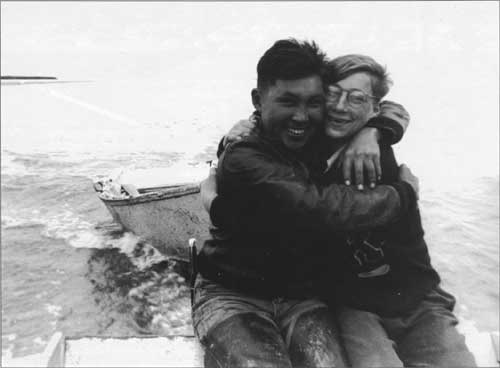
|
| Happy Abyo and Orin Seybert out fishing on the Ugashik River, date unknown. Photograph courtesy of the Pilot Point Tribal Council, Ace Griechen Collection. |
The first of these American capitalist interests was the Alaska Commercial Company, which sent its agents to the Alaska Peninsula to replace the Russian American Company traders. Because the peninsula remained on the periphery of the American fur trade, ACC agents, at first replicated the local system of trade developed between the Russians and the Alutiiq hunters. But as fur-bearing resources began to decline, the ACC began to employ more efficient business strategies and quickly ended the century-old, partner-building trade practices that had evolved between indigenous hunters and Russian traders. Conditions resulting from credit debt and racism began to deteriorate relations between hunters and the agents, while the basic economic unit among Native peoples was gradually shifting from the community to the single family.
As myriad historical forces joined together in the late nineteenth century, American capitalism dramatically began to replace prior economic systems that developed in and depended upon the natural environment of the Alaska Peninsula. Not only did the American system begin to break down a system of trade and exchange that had existed for nearly 150 years in the Aniakchak region; it also began to reshape relationships forged between people and the volcanic landscape that had managed to exist in some form or another for 9,000 years. Pools of oil attracted the interest of prospectors from the Lower 48 to the Native and Creole village of Kanatak in 1901. And, in attempts to socially and environmentally engineer the Alaska Peninsula, missionaries and the federal government teamed together to instill the spirit of entrepreneurialism in local residents by incorporating them into an artificially constructed reindeer industry.
Although the oil industry never found commercial-sized oil deposits in Kanatak and the reindeer industry failed to turn local residents into capitalists, another industry struck gold—red gold—for American businessmen. Canneries established an industrial complex, and imported American-made goods like boat parts and trapping equipment that appealed to local residents. They imported a work crew made up of people from places such as Scandinavia, Italy, Greece, China, Japan, and the Philippines, who interacted on varying levels with the local communities.
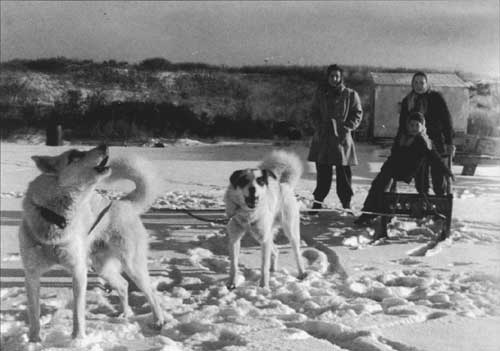
|
| Clarice Seybert, Anna Tracy and Josie Irons on sled, date unknown. Photograph courtesy of the Pilot Point Tribal Council, Ace Griechen Collection. |
Although most of these newcomers came to the Aniakchak region only seasonally, some remained. They married local women and supplemented fishing and cannery work with fox farming, trapping, and even a brief attempt at commercial razor clamming. Sadly, cannery ships brought infectious disease, as well. The Spanish Flu pandemic proportionately killed more people in Alaska than any place in the world. World War II introduced a new threat to the Aniakchak region—invasion from the Far East—first by the Japanese, and later, the Soviets. That threat catapulted the region onto the world stage, thus transforming the so-called fringe of North America into it newest geopolitical front.
* * *
Initial encounters with the Russians were destructive to Alutiiq culture. Some encounters were violent, others brought disease, and some brought new spiritual views that rivaled shamanistic practice. Most harsh was the decimation of the fur mammal populations, and ultimately, the Alutiit traditional relationship with the animals. Still, as unsettling as the massive slaughter of sea mammals must have been to Native hunters, much of the Russian fur trade in Aniakchak was conducted in patterns familiar to resident hunters, and moreover, remained basically within the local system. In other words, the Russians, who were too far from their homeland to bring conveniences, were assimilated—they were living off the land almost as much as the Alutiiq people were.
Most Alaska Native societies formed around relationships based on an egalitarian structure. Individuals worked together to gain what they needed from the surrounding environment—and the fish camp is a perfect example of such an economic structure. As long as trade relations between Alutiiq people and Russians traders were conducted in this mode, as they were in the Russian artels, then most activities—from hunting to trade to religion—remained essentially "Native" activities, which had been conducted by the Alutiiq for several hundred years. [5] Thus, the commercial-oriented relationship with nature developed side by side with more traditional views. Although some levels of alienation from traditional relationships resulted, most Alutiit managed to respond to the demands of the fur trade without entirely abandoning their older spiritual relationship with the world around them. This was most evident when the fur trade declined in the late nineteenth century, forcing many people to use pre-contact skills and knowledge to survive.

|
| Chignik seiner, 2004. Photograph courtesy of Katherine Johnson Ringsmuth, Anchorage. Alaska. |

|
| The past and the future, Chignik Lagoon, Alaska, 2004. Photograph courtesy of Katherine Johnson Ringsmuth, Anchorage, Alaska. |
This ability to deal with the advancing newcomers continued several decades after the United States purchased Russian America in 1867. American corporate interests, however, fundamentally altered traditional Alutiit system of exchange—in terms of both production and distribution. Canneries still made use of familiar 'Native' activities such as fishing, cleaning, and preserving salmon, but because the new industrial mode were a part of a system that existed entirely apart from the surrounding environment, the Alutiiq people no longer associated these activities with their traditional subsistence lifestyle. Still, change was a matter of degree. Because Native people were able to make the distinction between the cannery system and the traditional subsistence system, they were able to eventually engage in an American economy and culture without having them replace their own entirely.
Despite enormous economic changes that disrupted the interplay between culture and nature in the beginning of the twentieth century, many of the old ways continue. Language, for example, is being kept alive in classrooms. Most the inhabitants on the Alaska Peninsula remain members of the Russian Orthodox Church. Though they have limited access to grocery stores, most villagers still receive a major portion of their foodstuffs from the land, rivers, and oceans. And, while most people make their living as commercial fishers today, Alutiiq elders continue to teach their children how to show respect for the life force, the sua, of the salmon so that the fish will return the following year. [6]
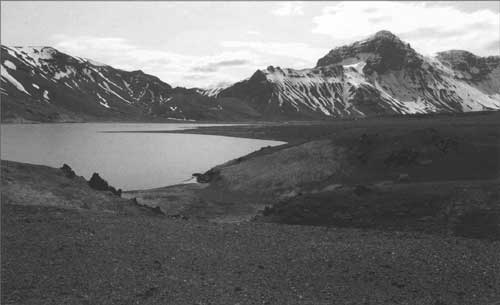
|
| Surprise Lake in Aniakchak Caldera. June 2003, NPS photo. |
Today we can understand the history of the central portion of the Alaska Peninsula as a convergence of diverse people. It is a place where Alutiiq shamans, Russian promyshlenniki, Orthodox priests, American traders, fox farmers, oil boosters, Inupiat reindeer herders, salmon packers, Army soldiers, scientists, park rangers and tourists interacted at various points in time. It is also a place that people did know, and have known for a very long time.
* * *
Father Hubbard generally ignored Aniakchak's human history and presented Aniakchak as an alien Moon Crater. Moreover, by introducing Aniakchak to the outside world, Hubbard brought that world to Aniakchak. Through his famed journeys into the Caldera and the writings, lectures, photographs and films that followed, the Glacier Priest made a truly profound contribution which still resonates today: Hubbard's activities and observations remind us that it is in places like Aniakchak National Monument and Preserve where we may go to ponder our relationship to a universe much larger than ourselves.
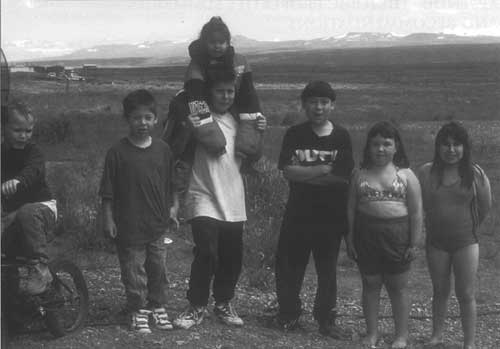
|
| Children of Port Heiden, 1996. Photograph courtesy of Tina Neal, USGS, Anchorage. Alaska. |
NOTES
2"The Hubbard Expeditions to Alaska," [Fr. McElmeel, ca 1954], copy in collection of Fr. Louis Renner, S.J., Fairbanks Diocese.
4Information provided by Becky Brock, chief of concessions for ANIA.
5For theories on how Alaska Natives made the transition from a subsistence to a market economy see James A. Fall, Molly B. Chythlook, Janet C. Schichnes, and Judith M. Morris, "An Overview of the Harvest and Use of Freshwater Fish by Communities of the Bristol Bay Region, Southwest Alaska" Technical Paper No. 166. Alaska Department of Fish and Game (1996): 70-71.
| <<< Previous | <<< Contents>>> | Next >>> |
hrs/conclusion.htm
Last Updated: 03-Aug-2009